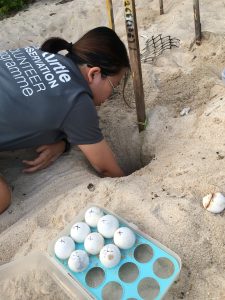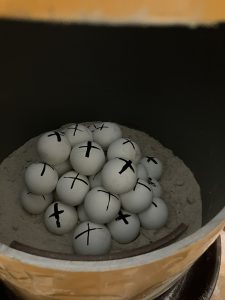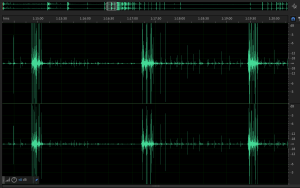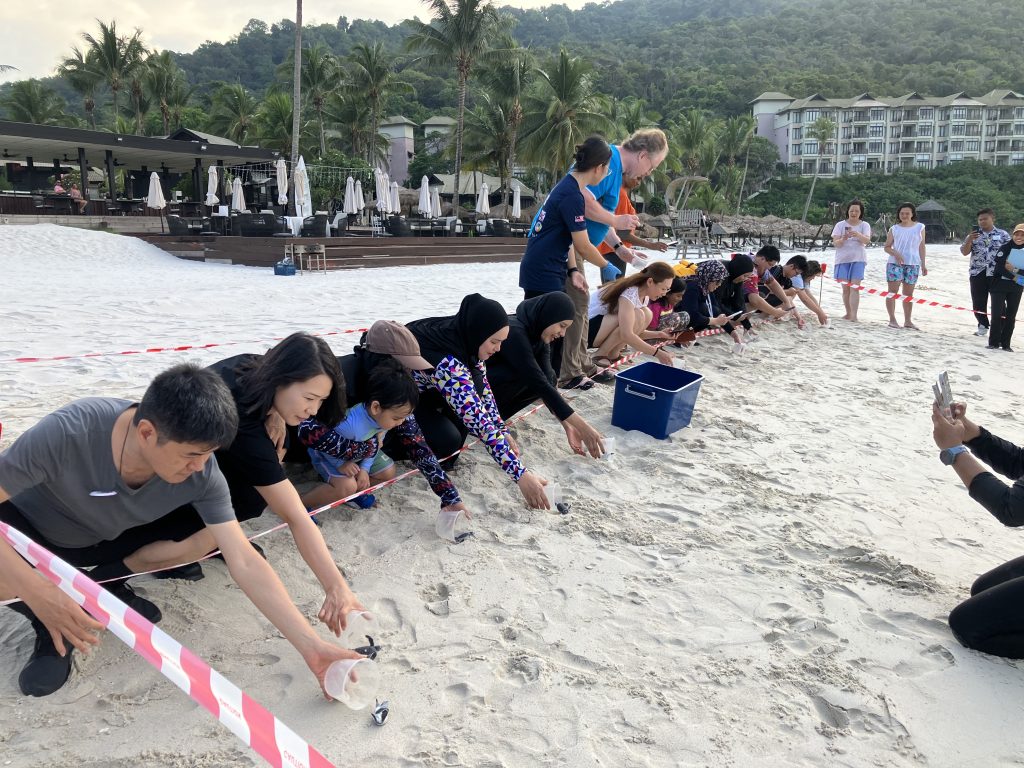ACOUSTIC MONITORING OF NEST EMERGENCE ACTIVITY IN SEA TURTLE HATCHLINGS
LIM PEY CHEN
Sea Turtle Research Unit (SEATRU), Universiti Malaysia Terengganu, Kuala Terengganu, Malaysia
lim.limpeychen@gmail.com
Download article as PDF
Introduction
The prolonged incubation period of 45-60 days for sea turtle eggs and the challenging emergence process from the nest 45-70cm below the beach surface for hatchlings are defining periods in the early life stages of sea turtles. Emergence from the nest is followed by initiation of the swimming frenzy, a crucial phase where hatchlings propel themselves toward their oceanic developmental habitat and initiate their feeding behaviours. Thus, the amount of energy expended during their emergence might be critical to their survival at sea.
The study aims to investigate the behaviour, digging time and duration, and energy expenditure of hatchlings during their emergence from the nest, as inferred from blood glucose levels and self-righting time, across different clutch sizes.
Methods
Green turtle (Chelonia mydas) eggs were collected from Chagar Hutang Turtle Sanctuary, Redang Island, Terengganu, Malaysia after 45 days of incubation (Figure 1) and transported to the laboratory at The Taaras Beach and SPA Resort, Redang Island within two hours, while maintaining their orientation. Eggs were divided into two groups- “big” and “small” clutch sizes- within the experimental design. Eggs and lavalier microphones were placed inside artificial nest chambers (Figure 2), and sound recorders were set up outside. Sound data (Figure 3) were collected continuously and analysed to determine digging duration, frequency, and hatchling emergence times.
Figure 1. Excavation of eggs 45 days after oviposition. The top of the eggs was marked with an “x” to maintain orientation during transport to the laboratory. (Photo credit: Siti Nur Syazwan)
Figure 2. Eggs in the artificial nest chamber before being covered in sand. (Photo credit: Lim Pey Chen).
Figure 3. Example of recorded digging activity by the hatchlings over time.
After emergence, morphological characteristics- carapace length, flipper length, external yolk sac size, and body mass- were measured. A self-righting test was performed to evaluate hatchlings’ ability to right themselves onto their plastron after being placed on their carapace. Blood glucose levels were measured in randomly selected hatchlings from both big and small clutches. Hatchlings were release at dusk at The Taaras Beach and SPA Resort beach (Figure 4), in association with a brief session on marine conservation for in-house guests.
Figure 4. Release of hatchlings from the study, with the participation of guests at The Taaras Beach and SPA Resort. (Photo credit: Vanessa Evangelista Jimmy)
All methods were approved by the Animal Ethics Committee of Universiti Malaysia Terengganu, and the research was supported by the Department of Fisheries Malaysia.
Findings to Date
We discovered that hatchlings from smaller clutches take longer to emerge from their nests, are larger, and have smaller external yolk sacs. Hatchlings from larger clutches have a shorter incubation period and emerge earlier and in larger groups, but tend to be smaller in size and have larger yolk sacs. Yolk sac size and the size of the emergence group have implications for hatchling survival, and it seems that hatchlings from different clutch sizes have unique characteristics for facilitating surviving in the wild.
Hatchlings from both clutch sizes spent more time in the egg mass at the bottom of the nest chamber than near the beach surface. This aligns with studies that found hatchlings commonly spend a few days within the egg mass to internalize residual yolk and rectify their posture from the curved position maintained within the egg to a straighter body (Miller, 1985). In addition to the distinct sounds of sand movement and the hitting of hatchlings’ flippers when they passed on the microphones, we found signals that might be hatchling vocalisations or sounds of breathing. These sounds prompt further exploration into how sea turtle hatchlings communicate and breathe after hatching from their eggs. As hatchlings approach the surface, their digging duration per event increases, signifying readiness for the crawl and swim frenzy that will quickly transport them across the beach and through inshore waters, habitats in which they are vulnerable to predators.
Apart from variations in digging duration across different nest depths, we did not notice a consistent pattern in the digging behaviour among experimental clutches. For instance, two different clutches of 20 eggs placed in separate chambers could exhibit completely different digging durations. This may arise from individual variability, maternal influences, and limitations in microphone detectable range. Inherent differences among individuals and potential genetic or environmental influences from the mother contribute to diverse digging patterns. Placing the microphone centrally in the chamber may not capture activities near the edges, introducing potential biases. Future studies can enhance accuracy by strategically placing additional microphones at different locations within the nest chamber. These variations in digging behaviour could reflect ecological and adaptive factors, warranting further investigation.
Relevance for Sea Turtle Conservation
This study presents valuable contributions in the realms of both fundamental research and conservation efforts. It uses a non-invasive method for detection and monitoring of underground digging activities in turtle hatchlings, providing a fresh approach to understanding their behaviour without disrupting their natural habitat. Furthermore, the research helps us to understand the significance of clutch size in shaping the development and emergence of sea turtle hatchlings and offers insights into the factors that influence their behaviour. These insights can be used in guidelines for hatchery management practices, such as maintaining natural clutch size and nest depth.
Literature cited:
Miller, J.D. 1985. Embryology of marine turtles. In: Biology of the Reptilia, Vol. 14A (eds. Gans, C., F. Billett & P.F.A. Maderson). Pp. 269-328. Wiley-Interscience: New York, USA.



